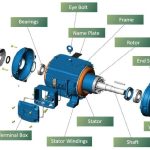What is a Brushless DC Motor?
A brushless DC motor (BLDC) is an advanced type of electric motor that eliminates the need for mechanical brushes and commutators. Instead, it uses electronic commutation to control motor operation. This design offers numerous advantages over traditional brushed DC motors.
Core Components
- Rotor
- Contains permanent magnets
- Made from rare earth materials like neodymium
- Mounted on the rotating shaft
- Multiple pole pairs for smooth operation
- Stator
- Contains electromagnet windings
- Usually three-phase configuration
- Made from laminated steel
- Precisely wound copper coils
- Electronic Controller
- Handles commutation
- Controls speed and torque
- Provides precise positioning
- Manages power efficiency
- Position Sensors
- Hall effect sensors
- Optical encoders
- Back-EMF sensing capability
- Provides rotor position feedback
Working Principles
- Electronic Commutation
- Controller energizes stator coils sequentially
- Creates rotating magnetic field
- Interacts with rotor magnets
- Produces smooth rotation
- Three-Phase Operation
- 120-degree phase separation
- Balanced power distribution
- Efficient torque production
- Minimal torque ripple
Advantages and Applications
Key Benefits
- Higher Efficiency
- No brush friction losses
- Better heat dissipation
- Reduced electrical losses
- Higher power density
- Improved Reliability
- No brush wear
- Lower maintenance needs
- Longer service life
- Better performance stability
- Better Control
- Precise speed control
- Accurate position control
- Dynamic torque response
- Wide speed range
- Operational Benefits
- Lower noise levels
- Reduced EMI
- Better speed-torque characteristics
- Higher power-to-weight ratio
Common Applications
- Consumer Electronics
- Computer cooling fans
- Hard disk drives
- DVD/Blu-ray players
- Home appliances
- Industrial Applications
- Automated machinery
- CNC equipment
- Industrial robots
- Process control systems
- Transportation
- Electric vehicles
- Hybrid cars
- Electric bicycles
- Drones and UAVs
- Medical Equipment
- Surgical tools
- Medical pumps
- Imaging equipment
- Laboratory instruments
Design and Selection Considerations
Motor Design Factors
- Power Requirements
- Voltage rating
- Current capacity
- Power output needs
- Efficiency targets
- Physical Constraints
- Size limitations
- Weight restrictions
- Mounting requirements
- Environmental conditions
- Performance Specifications
- Speed range
- Torque requirements
- Control precision
- Dynamic response
- Thermal Management
- Operating temperature
- Cooling method
- Heat dissipation
- Thermal protection
Selection Criteria
- Technical Requirements
- Power specifications
- Speed and torque needs
- Control requirements
- Environmental conditions
- Cost Considerations
- Initial investment
- Operating costs
- Maintenance expenses
- Lifetime value
- Reliability Factors
- Expected lifetime
- Maintenance needs
- Operating environment
- Duty cycle
- System Integration
- Control interface
- Power supply compatibility
- Mechanical integration
- Communication protocols
Maintenance and Troubleshooting
Preventive Maintenance
- Regular Inspections
- Visual checks
- Bearing condition
- Winding temperature
- Connection integrity
- Performance Monitoring
- Speed stability
- Current draw
- Vibration levels
- Temperature trends
- Environmental Control
- Dust protection
- Moisture control
- Temperature management
- Ventilation requirements
- Documentation
- Maintenance records
- Performance data
- Repair history
- Operating parameters
Common Issues and Solutions
- Electrical Problems
- Phase imbalance
- Sensor failures
- Controller faults
- Power supply issues
Typical Solutions:
- Check power connections
- Verify sensor operation
- Test controller functions
- Monitor phase voltages
- Mechanical Issues
- Bearing wear
- Shaft misalignment
- Unbalanced rotor
- Mounting problems
Solutions:
- Replace bearings
- Align shaft properly
- Balance rotor assembly
- Check mounting integrity
- Control Problems
- Speed instability
- Position errors
- Torque variations
- Communication issues
Solutions:
- Calibrate sensors
- Update control parameters
- Check feedback signals
- Verify communication links
Optimization Tips
- Performance Enhancement
- Fine-tune control parameters
- Optimize operating conditions
- Improve cooling efficiency
- Reduce electromagnetic noise
- Energy Efficiency
- Match load requirements
- Use efficient control strategies
- Minimize idle operation
- Implement power saving modes
- Lifetime Extension
- Follow maintenance schedules
- Monitor operating conditions
- Address issues promptly
- Use quality components
Future Trends
- Technological Advances
- Improved materials
- Better control algorithms
- Enhanced sensors
- Higher efficiency designs
- Integration Features
- Smart diagnostics
- IoT connectivity
- Predictive maintenance
- Advanced monitoring
- Market Development
- Cost reduction
- Performance improvement
- New applications
- Industry standardization









